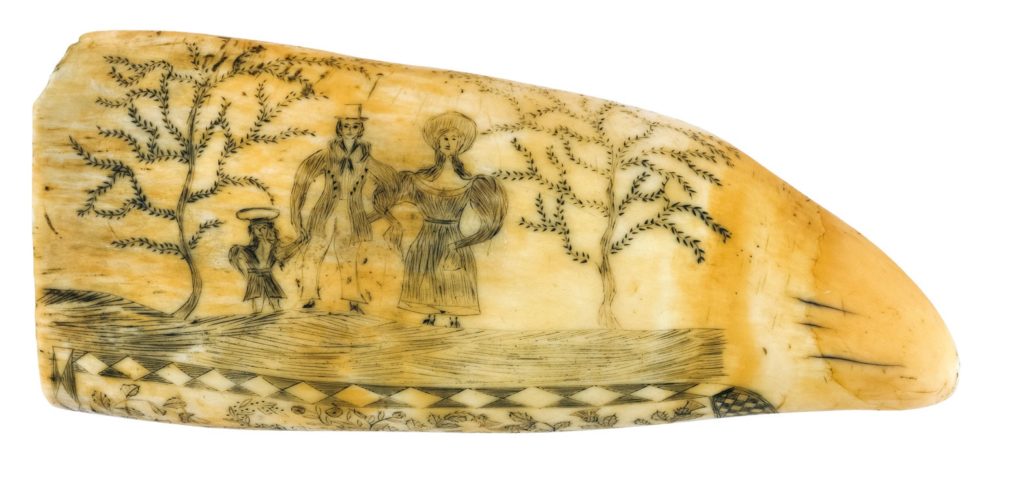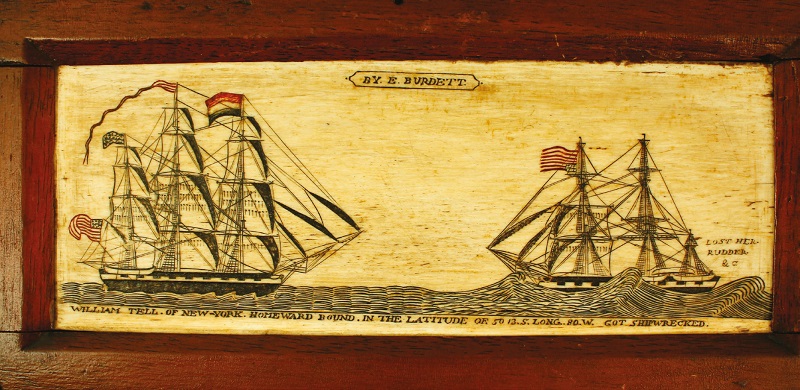Guide to collecting scrimshaw

at Eldred’s marine sale in July 20, 2017
While today we are most likely to proffer a bunch of roses or box of chocolates as a token of love, there was a time when what you needed to capture a lover’s heart was a piece of carved whalebone. Antiques advisor and buyer Elizabeth Fell reports on the growing demand for scrimshaw.
While collectors will always be drawn to opulence and decorative bounty, there can be something equally compelling about simple items, such as scrimshaw. Pieces hewn from materials that were close to hand – often by-products – and worked by an untrained hand.
These are items that impart a story from a time that we have left behind, packed tightly with enduring human emotion that reaches across the centuries to touch us. It is a genre encompassed by folk art in America and the UK, which has seen a remarkable renaissance in recent years.
What is scrimshaw?

Scrimshaw is the name given to a type of hand made craft created by carving the teeth and bones of whales and other marine mammals.
The objects are largely the result of mariners being confronted with time to occupy at sea and access to a ready supply of materials. Sailing, especially whaling, involved long periods of time when there was nothing to do and so ‘scrimshandering’ (crafting scrimshaw) occupied the men and kept them out of trouble at sea.
Origins of scrimshaw
The explosion of the whaling industry in the mid-18th century was fuelled by a requirement in the Western world for whale blubber. It was discovered that the fat could be boiled down to make whale oil, a substance that burns with a bright, white light and produces less smoke, odour or flicker than the beeswax or animal tallow that had lit houses for previous centuries.
Young, fit men from America and Europe took to the seas in their thousands, for months and even years at a time to meet the demand. Life aboard was hard; dangerous in storms and deadly during the frenzy of a whale chase and kill. Equally grim was the work of killing the whale then boiling down the carcass into oil. Aside from the toil, the passages were terribly dull, with weeks and weeks of inactivity while the crew searched the seas for their quarry.
Longing for home
It is understandable that the whalemen’s minds turned to home during these long hours. They would have yearned for comfort and security and the loved ones they had left behind. It’s hard for us to imagine the intensity of their longing.
Their farewells must have been unimaginably hard; a life at sea had an uncertain outcome. It would be difficult to estimate how long they would be parted, or be confident that they would indeed ever return from the sea.

During these times some sailors took to modelling and crafting the by-products of their trade into keepsakes to give to people at home. Sometimes they were purely decorative: whales’ teeth carved with images of home or a sweetheart left behind; or large shells pierced and decorated in filigree. But more often, they were domestic items made with their womenfolk and home in mind: sewing tools, thimbles, needle cases and yarn winders (known as “swifts”), bodkins, pie crimpers and of course, corset busks.
American scrimshaw

image courtesy of the New Bedford Whaling Museum
American whalers gave the art of inscribing and decorating marine items the name of “scrimshaw” and it was the publication of Herman Melville’s Moby Dick in 1851 which brought this folk art to the wider world on both sides of the Atlantic. The author describes the “lively sketches of whales and whaling scenes, graven by fishermen themselves on sperm whale teeth or ladies’ busks wrought out of the right whalebone, and other like skrimshander articles, as the whalemen call the numerous little ingenious contrivances they elaborately carve out of the rough material in their hours of ocean leisure.”
Scrimshaw love tokens
A busk, which was one of the whalers’ commonest love tokens, is a stiffener slipped lengthways into the front of a lady’s undergarments. Its purpose was to keep the front of the corset (and its wearer) straight and upright and prevent any creasing or wrinkling of the fabric of the dress.
Baleen busks
For centuries, busks had been made from wood, bone or ivory, but whalemen had access to baleen: the flat lengths of stiff keratin (the material from which horn, hair and fingernails are made) that make up the filtration system in a whale’s mouth. Baleen had a strength and plasticity that was perfectly suited to the job. Often it is misidentified as whale bone as it can be cream in colour, but sometimes dark, or opaque, a similar range of shades to horn, depending on the breed of whale from which it came.
Lampblack pictures
The whalemen would scratch the words and patterns into the baleen then use “lampblack”, a sooty oily by-product from the ships’ lamps, as a pigment to rub into the incisions. Occasionally busks were polychromatic if other sources of colour were available aboard ship, for example green verdigris deposits from copper or brass, or vegetable dyes from food.
Intimate images
Surely none of the intimacy of this item of women’s toiletry would have been lost on the sailor as he worked on a busk for his sweetheart at sea. Although distant, the thought that he could make a keepsake that would be worn inside his loved one’s dress, slipped between her breasts and close to her heart in his absence, would have been a compelling thought.
Busks were typically decorated with scenes from their travels, such as cityscapes, ports and boats, sometimes even depictions of the whale hunt itself. Many of them are also decorated with touching symbolism and coded messages of love.
Lovers motifs on scrimshaw
Surviving examples are carved and scratched with intertwined hearts, doves and flowers, images of couples with hoped-for children, churches that show their intent to marry, or fond memories of their weddings. The north star signified a hope to be guided safely home.
Wheatsheaves and cornucopia – a metaphor for future fertility, abundance and wealth – were common. A homestead, often with smoke rising from the chimney, expressed a longing for the comforts and security of home and dry land.
Human hardship

The physical and emotional potency of these items as a conduit for distant love has made them very desirable for marine collectors and folk-art connoisseurs. Some of the best examples belong to museums in fishing and whaling towns, as they illustrate the human hardships endured on the whaling vessels and by the families they left behind so eloquently, bringing history to us in a tangible, accessible way.
An example from the Smithsonian, dated 1836, is etched with a touching love poem:
With all my wandering
thoughts at sea
Dear G… I at times think of thee
I invoke thy prayers for
me and all
Who face the persistant
thunder squall
Whalebone to steel
In the third quarter of the 19th century, corset design changed and metal was introduced to replace whale bone. A busk was still a necessary component, but from this time on it was engineered from two long pieces of steel connected with hook-and-eye fastenings. This made dressing and undressing much easier for women, and possible to do without the help of a servant. In the 1920s, corsets were replaced altogether with bone-free elastic girdles.
Decline of whaling
At about the same time the whaling industry all but died out, new technologies provided cleaner fuel for lighting, and later in the century the International Whaling Convention was formed to preserve whale populations.
Almost as quickly as the whaling industry boomed, it faded away again, along with its associated folk art.
Perhaps that’s one of the reasons that busks remain such powerful, anthropological artefacts. They are reminiscent of a time we nearly hunted a species to extinction; of a time when men risked their lives on the high seas and left their wives and sweethearts behind them with their most intimate hopes and dreams, pressed into the warmth of her corset.
What to pay for scrimshaw
Because of their desirability and rarity, good busks command a high price. This, coupled with their relative simplicity makes them common targets for copies and forgeries, and there are many fakes on the market.
Collecters and dealers buy with extreme caution and look for provenance with which to assure onward buyers of authenticity and value. Many are snapped up by or donated to museums, particularly on the east coast of America where they are considered to be artefacts of their national heritage.
However, the more simple items, such as bodkins, thimbles and winders regularly turn up in our salerooms and markets (often in a box of other sewing items) and simple ones can be picked up for under £100. Perhaps these items are not imbued with the potency of the busks, but they provide an entry point to the scrimshaw market.
Scrimshaw World Record
A 20cm (8in) scrimshaw whale’s tooth by Edward Burdett set a world record in 2017 when it sold for $456,000 (£340,000). The 1830 piece was engraved: By. Edward Burdett. Of Nantucket. Onboard Of The Ship Wm Tell. On the obverse it read: Wm Tell. Of. New York. Cutting. Boiling. & Fast To A Whale.

Burdett was a pioneer of American scrimshaw, and in his short but prolific career he produced what are widely considered masterpieces of the genre. He was born in Nantucket in October 1805, the son of a merchant sea captain.
His first whaling voyage was aboard the Foster from 1822 to 1824. In successive voyages he sailed aboard the William Tell and the Montano. In November 1833, while serving as first mate onboard the Montano, Burdett was entangled in line, dragged by a whale overboard, and drowned.

